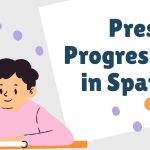The present progressive tense is key in Spanish for talking about what’s happening right now. You form it by using the right form of ‘estar’ and adding ‘ando’ for -ar verbs, or ‘iendo’ for -er and -ir verbs. It’s a bit like the English version, but getting it right in Spanish really helps you speak more fluently and fit in better with native speakers. So, what should you watch out for when using this tense?
Well, it’s easy to slip up. Sometimes people use it when they should just use the simple present tense. This can make your Spanish sound unnatural because native speakers don’t always use the present progressive for routine actions. It’s also good to double-check the verb ending. Mixing up ‘ando’ and ‘iendo’ is a common mistake that can confuse whoever you’re talking to. And remember, keeping your sentences clear and straightforward will help you communicate better.
What is present progressive in Spanish?
The present progressive in Spanish shows actions happening right now. It’s like when we use ‘am,’ ‘is,’ or ‘are’ with ‘ing’ in English, like ‘I am walking’ or ‘she is talking.’ This tense helps us talk about things that are happening as we speak. It captures what’s going on in the moment and gives us a feel of the action continuing.
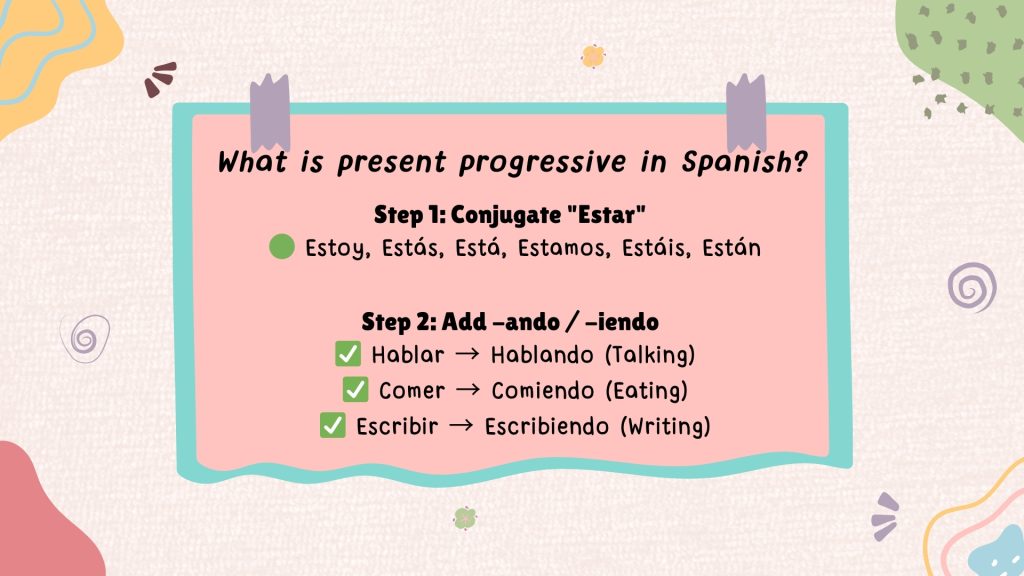
In English, we use:
✅ I am eating
✅ She is running
✅ They are studying
Spanish follows the same idea, using:
✅ Estoy comiendo (I am eating)
✅ Ella está corriendo (She is running)
✅ Ellos están estudiando (They are studying)
It’s always formed with estar (to be) + a verb ending in -ando / -iendo.
Step-by-Step Guide to Conjugating ‘IR’ in the Imperfect.
How to use present progressive in Spanish
In Spanish, to form the present progressive tense—which shows an action happening right now—you simply use the verb ‘estar’ and add a bit of a twist to the main verb. First, you change ‘estar’ to fit the subject. Then, if your main verb ends in -ar, you add ‘ando’ to the end; for verbs ending in -er or -ir, you use ‘iendo.’
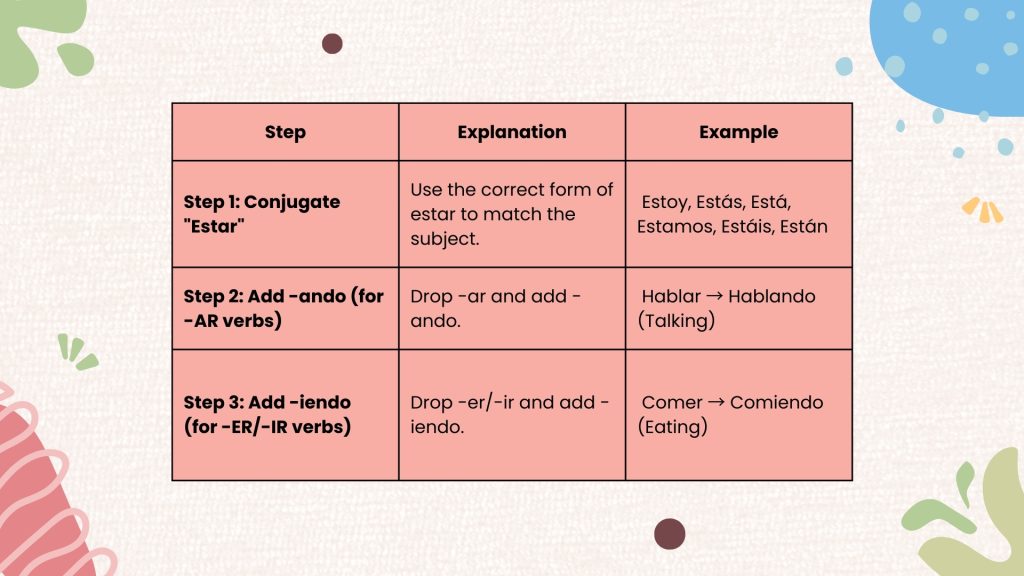
-AR Verbs
Most -AR verbs follow a simple pattern. Just drop -ar and add -ando.
✅ Hablar → Hablando (Talking)
✅ Bailar → Bailando (Dancing)
✅ Escuchar → Escuchando (Listening)
Example:
👉 Estoy bailando en la fiesta. (I am dancing at the party.)
-ER Verbs
For -ER verbs, remove -er and add -iendo.
✅ Comer → Comiendo (Eating)
✅ Leer → Leyendo (Reading)
✅ Beber → Bebiendo (Drinking)
Example:
👉 Estamos bebiendo café. (We are drinking coffee.)
-IR Verbs
-IR verbs work like -ER verbs—drop -ir, add -iendo.
✅ Escribir → Escribiendo (Writing)
✅ Dormir → Durmiendo (Sleeping)
✅ Pedir → Pidiendo (Asking for)
Example:
👉 Ella está escribiendo una carta. (She is writing a letter.)
-Irregular Verbs
Some verbs don’t follow the usual patterns. Their spelling changes a little to keep pronunciation smooth.
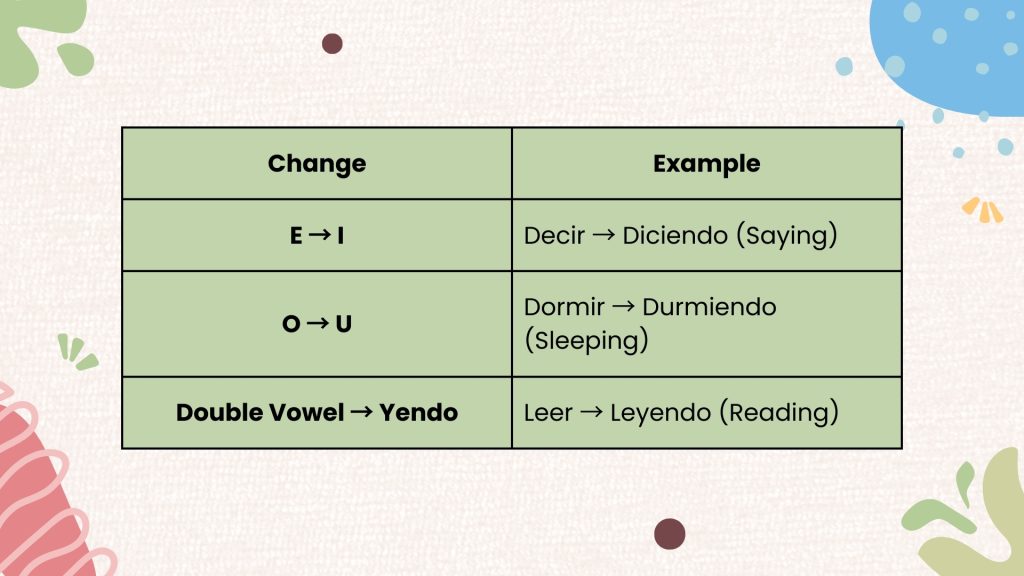
E → I
For some -IR verbs, the letter “e” in the root changes to “i” before adding -iendo.
✅ Decir → Diciendo (Saying)
✅ Pedir → Pidiendo (Asking for)
✅ Servir → Sirviendo (Serving)
Example:
👉 Estoy pidiendo ayuda. (I am asking for help.)
O → U
With certain -IR verbs, the letter “o” changes to “u” in the present progressive.
✅ Dormir → Durmiendo (Sleeping)
✅ Morir → Muriendo (Dying)
Example:
👉 Ellos están durmiendo. (They are sleeping.)
Yendo
If an -ER or -IR verb has a double vowel (like “leer” or “oír”), the ending changes from -iendo to -yendo to avoid awkward pronunciation.
✅ Leer → Leyendo (Reading)
✅ Oír → Oyendo (Hearing)
✅ Construir → Construyendo (Building)
Example:
👉 Estoy leyendo un libro. (I am reading a book.)
Understanding ‘Hacer’ in the Preterite Tense – Complete Breakdown
When to Use the Present Progressive
Knowing when to use the present progressive in Spanish is key if you want to talk about things that are happening right now. This tense helps you describe ongoing actions.
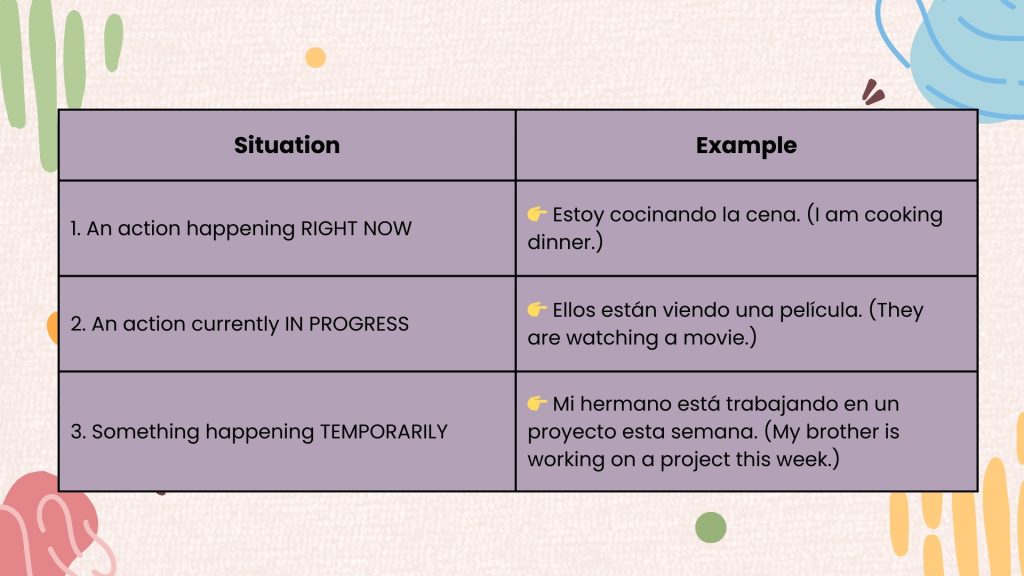
For example, you can say ‘Estoy estudiando’ to mean ‘I am studying’, or ‘Estás cocinando’ to tell someone ‘You are cooking’. It’s great for showing that something is happening as we speak.
| Situation | Example |
|---|---|
| An action happening right now | ✅ Estoy estudiando. (I am studying.) |
| An action currently in progress | ✅ Estamos comiendo. (We are eating.) |
| Something happening temporarily | ✅ Él está viviendo en Madrid este mes. (He is living in Madrid this month.) |
| To emphasize an action in progress | ✅ Ella está escribiendo una carta. (She is writing a letter.) |
When NOT to use the present continuous
The present progressive tense is great for talking about things happening right now. But, it’s not the best choice for regular habits or universal truths. Instead, use the simple present for these.
For example, say ‘She reads every night’ to talk about a routine, or ‘Water boils at 100 degrees Celsius’ to state a fact. These examples aren’t about temporary actions; they’re about regular or fixed realities.
| Situation | Use Instead | Example |
|---|---|---|
| Talking about habits or routines | Present simple | 🚫 Estudio todos los días. (I study every day.) |
| Talking about future plans | “Ir + a + infinitive” | 🚫 Voy a comer más tarde. (I’m going to eat later.) |
| Describing permanent situations | Present simple | 🚫 Él vive en Madrid. (He lives in Madrid.) |
| With verbs of motion (ir, venir, llevar, seguir, etc.) | Present simple | 🚫 Voy al cine. (I am going to the movies.) |
Conclusion
To put it simply, learning the present progressive tense in Spanish is key when you’re talking about actions happening right now.
You make it by using the verb ‘estar’ plus a gerund. This lets you describe ongoing activities clearly.
It’s good to know when to use this tense and when not to, so you can communicate more clearly and effectively in Spanish.
This helps you talk about things as they’re happening, making your conversations more lively and accurate.
Lingua Viva: Where Language Learning Meets Success!
Carolina is a charming and lively member of Lingua Viva with 11+ years of teaching experience. She loves to teach students appropriate ways to communicate effectively in Spanish without the fear of making mistakes. She holds a professional teaching license and has a graduate degree with emphasis in Foreign Language.


